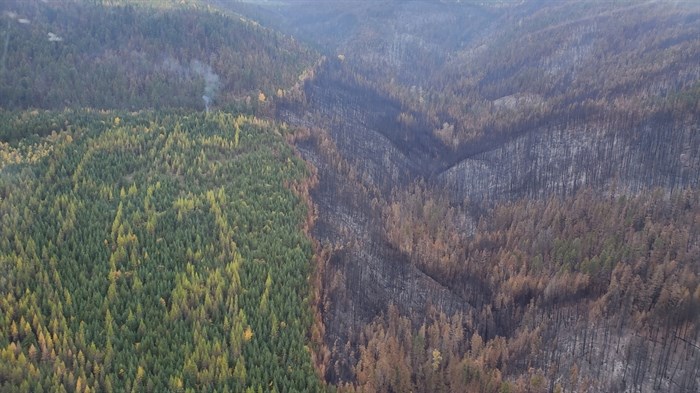
This photo shows an area 600-1,000 metres south of Naswhito Creek on the west side of Okanagan Lake that was burned by the White Rock Lake wildfire last summer. Areas that were logged and replanted escaped the fire, as did areas with deciduous trees.
Image Credit: Submitted/Bob Hrasko
October 22, 2021 - 6:00 AM
Not everyone can jump into a helicopter just to look at the true impact of events like the White Rock Lake wildfire.
But Bob Hrasko, manager of the Black Mountain Irrigation District in Kelowna, was given that ride by cherry grower David Geen earlier this month.
Geen has 115 acres of cherries that are dependent on Naswhito Creek for their water supply so he wanted to look at the impact of the fire on his water source, which enters Okanagan Lake near Okanagan Indian Band lands on the west side of the lake, near where the fire destroyed a dozen properties.
“It was lot more positive than we had expected,” Hrasko told iNFOnews.ca. “We were hoping there was lots of forest cover still there, and there was.”
That included large areas that had been replanted in recent years that were untouched by the fire and lots of deciduous trees that escaped the flames.
Part of that had to do with the fact that there was more moisture in the soil at higher elevations because the snow melted later on, so only about five per cent of those lands were burnt. Middle elevations in the Naswhito Creek watershed were about 20% burnt and 35-40% at lower elevations, Hrasko estimated.
While elevation was likely a big factor, those areas that had been replanted were also spared.
“They logged those areas so the understory – all the pine needles and all the stuff that would have been sitting on the ground – wasn’t there because they logged it not too long ago, like 10, 15 years ago,” Hrasko said.
The fire burned in fingers down into the Naswhito Creek watershed, all the way to where the Little Kingdom Gas Bar and a dozen homes on Okanagan Indian Band lands were destroyed.
READ MORE: Okanagan Indian Band working on recovery plan after homes, business destroyed by wildfire
For the most part, the fire didn’t burn right down to the creek but there are still risks to the creek, depending on the snowpack this winter and how quickly it melts next spring.
“We’ve got some pictures of some areas where it’s just charred ash,” Hrasko said. “In those areas, your soils can go hydrophobic, meaning they repel water because you’ve melted the actual soil. So it’ll just shed the water, it won’t absorb any of the water.”
Black Mountain Irrigation District gets its water from the Mission Creek watershed, which is on the east side of Okanagan Lake.
There have been numerous clear cuts in that watershed but Gorman Brothers wants to do more selective logging in steeper slopes leading down to the creek in order to minimize fire risks. That has sparked strong opposition from the community but Hrasko is all in favour.
“The problem we have up in Joe Rich is, the community is up in arms and don’t want any logging at all but, at the same time, they’ve got a fuel load all around them that’s just not manageable,” Hrasko said.
As a result, he sent an email to Joe Rich community leaders as well as local MLAs and the regional district representative with some recommendations for forestry practices that apply far beyond just the Joe Rich area.
“What (Black Mountain Irrigation District) would like to see in the Mission Creek watershed is continued logging to reduce fuel levels,” Hrasko wrote. “However, we would also like to see adjusted fire management techniques with regards to the replanting of forest.
“The techniques could include, with each cut block and replant, 30-metre wide buffer areas of deciduous trees to create a patchwork of boundaries that would slow down future fires and provide a barrier between the coniferous pine-spruce-fir cut-block replant areas.”
The historical planting of coniferous species has contributed to the severity of wildfires, he said.
“The province gets revenue out of this too,” Hrasko said. “They haven’t set up any kind of barrier system. It’s all planted for spruce, pine, fir. As a result, things burn a little bit quicker sometimes than they ought to. It’s not a natural watershed.”
READ MORE: How Vernon is planning to get ahead of the next fire season
To contact a reporter for this story, email Rob Munro or call 250-808-0143 or email the editor. You can also submit photos, videos or news tips to the newsroom and be entered to win a monthly prize draw.
We welcome your comments and opinions on our stories but play nice. We won't censor or delete comments unless they contain off-topic statements or links, unnecessary vulgarity, false facts, spam or obviously fake profiles. If you have any concerns about what you see in comments, email the editor in the link above.
News from © iNFOnews, 2021